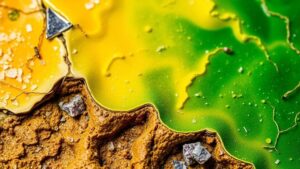Spotting Associated Minerals Like Galena and Sphalerite in Carbonate Veins
Spotting Associated Minerals Like Galena and Sphalerite in Carbonate Veins
Minerals such as galena (PbS) and sphalerite (ZnS) often form in association with carbonate veins. Understanding how to recognize these minerals can be crucial for geologists, miners, and environmental scientists in areas ranging from resource extraction to ecological studies. This article explores the characteristics of galena and sphalerite, the formation of carbonate veins, and strategies for effective identification in the field.
Understanding Galena and Sphalerite
Galena is the primary ore of lead and is known for its metallic luster and high density. It typically appears as a cubic crystal or granular form, often with a grayish-blue or lead-gray color. Sphalerite, on the other hand, is the chief ore of zinc. This mineral is characterized by its resinous luster and can exhibit a range of colors, usually varying from yellow to brown to black, depending on the presence of iron.
Formation of Carbonate Veins
Carbonate veins commonly form in sedimentary rock environments where fluid can migrate through the rock, depositing minerals. e veins are often rich in calcium carbonate (calcite) and can serve as conduits for the movement of hydrothermal fluids, leading to the precipitation of various minerals, including galena and sphalerite.
- Hydrothermal Processes: Hot, mineral-rich fluids can move through fissures in carbonate rocks, depositing metallic sulfides as they cool.
- Weathering: The weathering of primary sulfide minerals can lead to the secondary formation of these minerals within the carbonate context.
Identifying Galena and Sphalerite in Carbonate Veins
Recognizing galena and sphalerite in the field can be a challenging yet rewarding process. Here are some strategies and characteristics to consider:
- Visual Inspection: Look for galenas shiny, metallic luster and distinct cubic cleavage. Sphalerite often displays a resinous quality, with a tendency to show a bright, shiny surface when scraped.
- Weight and Density: Galena is considerably denser than most other minerals. It can be useful to compare the heft of a suspected galena sample against a known lighter mineral.
- Streak Test: Performing a streak test on a porcelain plate can help as galena produces a gray streak while sphalerite often yields a white to yellow streak.
Case Study: Mining Operations in the Southwestern United States
In regions like the Southwest United States, particularly the area around the Tucson basin, researchers have documented significant occurrences of galena and sphalerite within carbonate veins. Notably, the Twin Buttes mine has yielded high-quality specimens of these minerals. The interplay between the mineralization processes and the geological history of the region makes it an exciting area for both study and mining.
Real-World Applications
The ability to identify galena and sphalerite in carbonate veins is not merely an academic exercise. e minerals have significant industrial applications:
- Lead from Galena: Used in batteries, radiation shielding, and ammunition.
- Zinc from Sphalerite: Essential for galvanizing steel and in the production of various alloys.
Conclusion and Actionable Takeaways
Understanding how to spot associated minerals like galena and sphalerite within carbonate veins can enhance ones ability to assess resource potential and explore geological formations efficiently. Here are some actionable takeaways:
- Familiarize yourself with the physical properties of galena and sphalerite.
- Use field tests to differentiate between similar-looking minerals.
- Study local geology to understand fluid movement and mineral deposition in carbonate environments.
By applying these principles, practitioners and enthusiasts alike can improve their geological skills and contribute to effective resource management and exploration.


